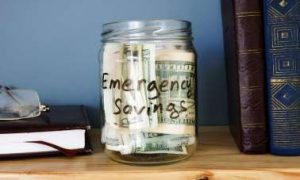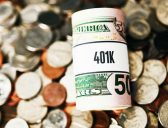While they may be similar, rainy day funds and emergency funds are not the same.
The second you start making money is likely the best time to start saving it. You never know when something unexpected will happen, which is why it’s essential to be prepared. Unfortunately, not having enough money saved is a common problem. Twenty-eight percent of American adults would have difficulty paying their monthly bills if they had to pay an unexpected expense of $400, according to the Federal Reserve.
Although $400 may not seem like a huge expense, it’s the unexpected nature of it that might throw you off. If something isn’t in your financial plans, it’s probably not accounted for. And if you don’t have any cash on hand, you may have to go into credit card debt to cover a sudden expenditure.
This is where a rainy day fund comes into play. Set aside money in a rainy day fund for situations you can’t necessarily foresee, but you assume could happen. A rainy day fund is similar to an emergency fund, but not exactly the same.
Here, we’ll look at what a rainy day fund is and the different ways you can start building one today.
What is a rainy day fund?
When you “save for a rainy day,” you’re typically saving money for an unforeseen circumstance that will cost something. This could be a car repair, replacing your washing machine, or a similar occurrence. The money you put away for these events is called a rainy day fund.
Although you can’t make an exact prediction on when you’ll need money from your rainy day savings, you know you’ll likely need it at some point. For instance, your car isn’t going to last forever, even if you do routine maintenance. It’s a fact that some part of your mechanical vehicle will eventually need repair. The repair isn’t actually unexpected, but the timing of it is.
Rainy day funds are primarily meant for smaller expenses. Generally, these expenses are one-time or short-term costs. There’s no set limit on how much money you can put into your rainy day fund, but it should be enough to cover an expense of at least a few hundred dollars. You may even want up to $1,000 as an extra safety net. The more money you have saved, the better prepared you’ll be when you need it.
Keep in mind, rainy day funds are not the same as emergency funds. Emergency funds are typically much larger because they’re intended to cover major emergency expenses.
What is an emergency fund?
An emergency fund is money you save for financial emergencies. It’s not the same as putting away money in case your car gets a flat tire or your washing machine breaks. Rather, this is a fund you create and add to in case you lose your job, get injured, or come down with a serious illness. You’re saving for a potential financial disaster that could cost thousands of dollars or more.
In the event of a job loss, what kind of money would you need to survive for the next three to six months? How much savings would you need to continue paying bills and everyday expenses? If you can answer these questions, you have a good idea of how much money you need for your emergency savings.
Keep in mind, there’s no limit on the amount you can put into an emergency fund. If you calculate your income levels for a few months, you’ll get a rough estimate as to what you might need if you’re not working, but that same amount might not cover a different situation. It’s hard to tell for sure how much money you would need if you were to get injured or become sick. The best practice is to have enough to replace your income for a short while, and then add more as you think you need it.
An emergency fund is different from a rainy day fund because of the scope of events and circumstances you’re saving for. Replacing your refrigerator isn’t quite the same as replacing your entire source of income. Emergency funds are meant for bigger expenses, so they’re typically much larger than rainy day funds.
Do you need both a rainy day fund and an emergency fund?
Everyone should have both a rainy day fund and an emergency fund. Having both makes it much easier to separate your savings for their intended purposes. And yes, you do want to separate the two funds from each other.
Let’s say you have a rainy day fund and an emergency fund, but they’re both in the same bank account. Now, if you need funds for something, regardless of what it is, you have to pull from that savings account. This could potentially take money away from one of the funds, which may leave you short if you need that money later.
When you have both funds and separate them, you can’t accidentally reduce the amount in either one. If you need money to fix a broken window, pull that money directly from your rainy day fund. If you or a family member needs to have their appendix removed, use money from your emergency fund if you need it.
With only a rainy day fund, you may not have the money you need for a large financial emergency. Similarly, with only an emergency fund, you’ll likely need to dip into it for modest expenses, like car repairs or a new appliance. What happens if you have a big financial expense and your emergency fund isn’t nearly where you need it to be?
When you have both a rainy day fund and an emergency fund, you’re more likely to be prepared for an unforeseen expense, whether big or small.
3 ways to boost your savings
It’s not always easy to start saving money, but certain strategies can help you boost the amount of money you’re putting away. If you’re looking to save more for a rainy day fund and/or emergency fund, consider these three options:
1. Choose the right savings account
Not every savings account is created equal. They’re all meant to help you save money, but some of them do little more than hold your money for you, without earning much interest in the process. According to the Federal Deposit Insurance Corporation, the average APY for a traditional savings account is just .06%, as of Aug. 3, 2020. At this rate, you’d earn $6 in a year if your savings account had $10,000 in it ($10,000 x 0.0006 = $6).
Unfortunately, the national interest rate posted by the FDIC is the average of financial institutions around the U.S. So most traditional savings accounts aren’t worth using if you want to accrue interest on your money. Instead, consider a high-yield savings account for better returns. These are some of the best savings accounts available if you want to earn interest on your money. Plus, there are no penalties for taking funds out of these accounts, so you can easily access your money if you need it.
High-yield savings accounts earn more than the national average. For example, the CIT Bank savings account has a .95% APY (as of Aug. 3, 2020). At this rate, you’d earn $95 in a year with a $10,000 ($10,000 x 0.0095 = $95) account. And if you use an automated savings tool like Digit, you can easily pad your savings. Digit helps you calculate how much you can save after taking all your bills and expected purchases into account. It takes the thinking out of saving and does it for you while you continue your everyday lifestyle.
2. Get a cashback credit card
Using the best cashback credit cards can help you save money for your rainy day fund and emergency fund. These types of credit cards typically earn cashback on every purchase, which is money straight back into your wallet. At that point, it’s easy to put that extra money straight into a savings account for when you need it.
Credit cards like the Citi Double Cash Card and Chase Freedom Unlimited offer simple and straightforward earning opportunities. With the Citi Double Cash, you earn up to 2% cashback on all purchases: 1% as you buy and 1% as you pay. With the Freedom Unlimited, you earn unlimited 1.5% cashback on all purchases. Because you can redeem rewards on either card for cash, it’s a painless way to boost your savings. Just use a cashback card for everyday purchases, earn cash back, and put that cash toward your savings.
3. Pick up a side hustle
If you really want to boost your savings, picking up a side hustle is an ideal solution. Side hustles with Postmates and DoorDash allow you to choose your own hours while earning extra money. Signing up is free for both delivery services and it can be quick and simple to start. As soon as you’re approved, you can take orders and start making deliveries.
Side hustles are meant to help you reach your financial goals. So if your goal is to build your rainy day and emergency funds, a side hustle can help you get there. Side hustles aren’t meant to replace your main source of income, but the bonus cash can go toward your savings.
The bottom line
A rainy day fund may be different than an emergency fund, but they’re both important financial cushions. To build them, you can start small and put a few dollars away here and there, but try to be consistent with your savings. When you need the money, you’ll be glad you started these funds and put money into them.
Remember to use sound financial strategies to boost your savings. Whether it’s a high-yield savings account, cashback credit card, or side hustle (or all three), choose the method that works best for you and your lifestyle. Any money you can put away offers peace of mind and financial protection for your future.
The post Is a rainy day fund the same as an emergency fund? appeared first on Mediafeed.org and is written by Ben Walker
Original source: Mediafeed.org






